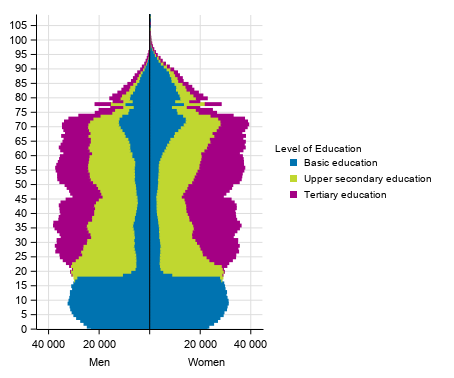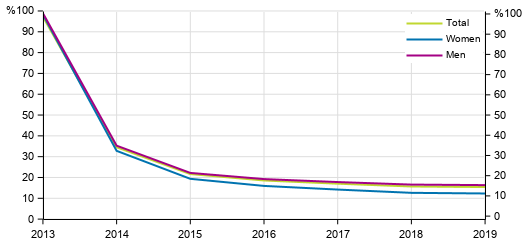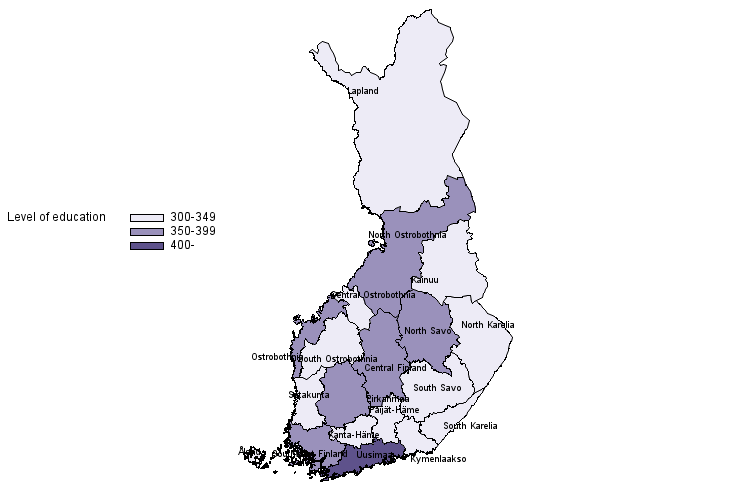Published: 5 November 2020
Educational qualifications highest among persons aged 40 to 44 in 2019
By the end of 2019, altogether 3,435,387 persons, or 74 per cent of the population aged 15 or over had completed a post-comprehensive level qualification. The share of persons with an educational qualification grew by one percentage point from the year before. Thirty-two per cent of the population had completed a tertiary level qualification.
Population by gender, age and level of education 2019

Basic education includes persons, whose qualifications attained abroad are not known
Upper secondary education includes specialist vocational qualifications
In 2019, the highest educated persons were those aged 40 to 44, of whom 88 per cent had completed a qualification and 47 per cent a tertiary level qualification. In all, 87 per cent of persons aged 45 to 49 had completed a qualification and 46 per cent a tertiary level qualification. These data derive from Statistics Finland’s Education Statistics.
Thirty-six per cent of all women aged over 15 had completed tertiary level qualifications and 25 per cent of women had basic level qualifications. Overall, 28 per cent of men had completed tertiary level qualifications and 28 per cent were without a post-comprehensive level qualification. The differences between genders were even bigger in younger age groups. In women aged 30 to 34, tertiary level qualifications had been attained by 48 per cent and 12 per cent were without a post-comprehensive level qualification, while for men the corresponding shares were 33 and 18 per cent. The database tables describe the shares and numbers of those with qualifications examined by gender, age group and area.
Population born 1995 without upper secondary degree, % of age cohort

The cohort of persons born in 1995 came of age in 2013, when nearly all of the age group were still without upper secondary level qualifications. In 2014, the share of persons without upper secondary level qualifications was 36 per cent, after which the share of persons without upper secondary level qualifications has fallen steadily. Persons born in 1995 turned 24 in 2019, when 14 per cent had no upper secondary level qualifications, 16 per cent of men and 13 per cent of women.
The share of those without upper secondary level qualifications has remained unchanged regardless of the age cohort, although more of those born in 1985 did not have an upper secondary level qualification. Seventeen per cent of persons born in 1985 were without upper secondary level qualifications when the age cohort turned 24. One in five men were without a secondary level qualification and 14 per cent of women. Fifteen per cent of those born in 1975 were without upper secondary level qualifications when the age group was 24 years old. Of men 17 per cent had no upper secondary level qualifications and of women 13 per cent.
In 2019, there were 103,166 persons aged 20 to 29 with only basic level education, making up 15 per cent of the age group. Among men, 18 per cent of the age group had only basic level education and 13 per cent among women. The number of persons aged 20 to 29 with only basic level education was highest in ┼land, where 23 per cent of the age group had no post-comprehensive level qualification. The share of persons with only basic level education was lowest in North Karelia, South Ostrobothnia and Central Finland, where 12 per cent of those aged 20 to 29 had no post-comprehensive level qualification. Persons whose qualifications attained abroad are not known are also included in those without a basic level qualification.
Population by the measure of level of education based on length of education in 2019

The highest educated population lived in Uusimaa in 2019. The population's measure of level of education indicates the average length of the highest level of completed education per capita. In Uusimaa, the population had completed an average of 4.3 years of post-comprehensive level education. The second highest educated population lived in Pirkanmaa, where the population had completed an average of 3.9 years of post-comprehensive level education..
Source: Education 2018. Statistics Finland
Inquiries: Mika Witting 029 551 3530, koulutustilastot@stat.fi
Head of Department in charge: Hannele Orjala
Publication in pdf-format (276.7 kB)
- Tables
-
Tables in databases
Pick the data you need into tables, view the data as graphs, or download the data for your use.
Appendix tables
Updated 5.11.2020
Official Statistics of Finland (OSF):
Educational structure of population [e-publication].
ISSN=2242-2919. 2019. Helsinki: Statistics Finland [referred: 28.8.2025].
Access method: http://stat.fi/til/vkour/2019/vkour_2019_2020-11-05_tie_001_en.html

